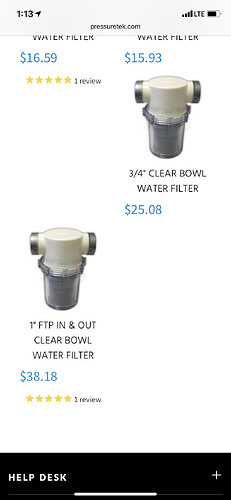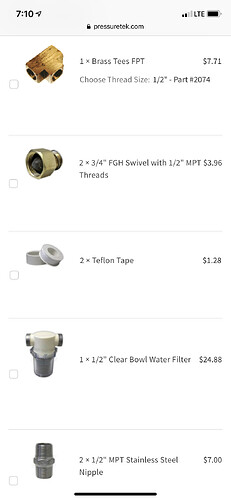Yes, but a barb and hose is a better option.
That filter will get clogged quickly and starve the pump. Local shop put one on my back up and I plan on taking it off if it ever gets put back into use.
It’s not recommended, but I do it. I need to be able to remove my tanks for maintenance and to free up space for snowblowers in the winter.
I’ve heard that flange fittings are a better option for semi-permanent vacuum connections.
That does make it easier… i have always thought about if it worked or not, i have normal fitting from buffer.
So if I were to put a 1/2” nipple onto my tee, & thread the filter on, then attach a 3/4” fgh adapter on the other side, which one of these clear ones should I get? I’m not sure what “in & out” means. Aren’t they technically ALL “in & out”?
All plumbing before your pump should be 1”. Here’s a pretty decent guide on how everything should be plumbed:
https://www.pressurewasherproducts.com/pressure-washer-plumbing.html
This will get your 1” plumbing down to 1/2” for the pump inlet:
That diagram looks great! However, I do not have a buffer tank. Not ready to make that leap yet. Maybe when I decide to buy an 8gpm machine. And I thought my only problem was the stupid filter!
I have a 4gpm, before I bought a bigger 5.5 and added them both to a buffer tank with bigger filters to run them both @ the same time ,I used that 1/2" filter with the white bottom ,worked great,however if I did it again, I’d go for the 1/2 " clear,because there’s no guessing when you need a filter flush. If your hooking up to a regular spigot ,the 1/2 " is all you need. Take off the female hose connection you have now and get filter according to the hole diameter of the T ,I’m assuming its 1/2 fpt. I really can’t see what that T is for WO a better pic. Also, The in and out does matter. Don’t mess that part up ,or you just bought another thing to restrict your water flow and filtering nothing…
What exactly does the in & out mean? I can’t seem to find a description of the difference of that and a regular one.
The tee has 3- 1/2” female inlets: a 1/2” nipple to connect it to the pump in the middle, a hose going to the unloader (bypass, which has a 3/8” connection), and a 1/2” to 3/4” FGH adapter.
The “in” and “out” is the direction of water flow. Your garden hose or supply hooks to the in and then out goes to washer.
I think you ought to get a small buffer tank. It makes a world of difference. No worrying about being on the gun. I think if I didn’t have a buffer I’d quit washing. That’s how much easier it makes it. It doesn’t have to be some huge tank. They do have guns called “weeping” guns or something like that. If you don’t have a buffer the gun weeps a little water when off the trigger to keep pump cool.
Those weep guns are used at coin wash bays to keep the water from freezing. You’d need about twice the flow they offer to keep the seals from cooking.
Do you know the internal hex size I need to use for a 1/2” male thread x 3/4” fgh swivel connection? I bought a large hex set from amazon, but the smallest size is still too big. The one I bought is the 2nd one down in the photo.
Not off the top of my head. I used a hex bolt I had laying around. Stuck the bolt head in, and turned the bolt with a pipe wrench. I would ditch the garden hose fitting anyways, as the swivel fittings can allow air to get sucked into the pump when pulling off a buffer. Male thread to hose barb is a better option. If it’s a smaller gpm machine that’s being force fed directly from a spigot, swivel is ok though.
Sometimes you can use two smaller allen keys together to turn a large fitting like that.
You can even use two allen keys as a makeshift internal pipewrench


























